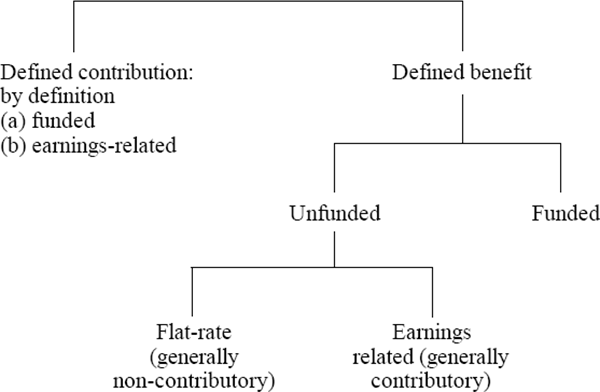RDP 9603: Australia's Retirement Income System: Implications for Saving and Capital Markets 1. Basic Features of the Australian System
September 1996
- Download the Paper 145KB
Australia is currently in the early stages of introducing a system of self-provision for retirement through mandatory contributions to private superannuation funds. The system will take several decades to mature but, when it does, will substantially replace the government age pension, currently relied upon by a large majority of retirees. Since the government pension is unfunded,[1] the overall transition represents a move from a predominantly unfunded to a predominantly funded basis for retirement incomes over the next few decades. In making this transition, Australia is one of relatively few countries moving towards a funded scheme, and is almost unique in adopting a system that is government-mandated but privately operated. The purpose of this paper is to outline the basic features of the Australian system and its historical background, and to give some analysis of its possible impact on saving and capital markets.
The current policy has been put in place through a series of initiatives, to be elaborated upon in Section 2, which began in the mid 1980s. The various initiatives did not follow a pre-announced plan, but nonetheless have progressively established an overall timetable for phased increases in mandatory saving which now has bipartisan political support. The first main step was the introduction of a mandatory employer contribution to approved superannuation funds on behalf of each employee, set initially at 3 per cent of salary. Subsequent policy decisions have provided for these to be increased, and to be supplemented by employee and government contributions, which together are scheduled to bring the total to 15 per cent of salary when the timetable is fully implemented in the 2002/03 financial year. Additional voluntary contributions are also possible. Although the maximum level of compulsory contributions is thus scheduled to be reached in only a few years from now, it will be some decades before the system matures in the sense of yielding maximum retirement incomes. Because final benefits for each individual will depend on the amount of savings they accumulate, the maximum level of benefits accruing from the compulsory contributions will not be attained until retirement of the first generation with an entire working-life under the new system.
The superannuation funds which receive the compulsory contributions are, in contrast to many countries, privately run and managed. They are also typically defined-contribution plans. In introducing the new scheme, the government has been able to take advantage of the existence of an already-large superannuation sector, which handled voluntary savings of predominantly high income earners. This has meant that the compulsory scheme has been able to make use of a well-developed financial infrastructure already in place. In effect the government has decided to expand a savings vehicle in use by a minority through the introduction of mandatory contributions for all employees.
Traditionally, the main source of government provision for retirement income in Australia has been a flat-rate age pension, which provides a means-tested payment generally indexed to 25 per cent of average weekly earnings. This pension has existed for several decades and will remain in place as a safety net for those who do not accumulate sufficient private provision under the new system. The pension is funded from general government revenue and has never been contributory or related to an individual's previous income. Although the pension is means-tested and, in that sense, regarded as a safety net, it is currently the main source of income for more than 60 per cent of retirees.
To provide an international context for the Australian system the diagram below gives a simple taxonomy of possible retirement schemes.

Many industrial countries have opted for various forms of unfunded but contributory defined benefit schemes. A common characteristic of such schemes is that end-benefits are related to an individual's contributions record, but that those benefits are not funded from contributions in an actuarial sense. This gives rise to a quasi-contractual set of unfunded liabilities of the social security system for future pensions. For countries with this type of system, an important consideration in any transition to a funded scheme concerns the treatment of these existing unfunded liabilities. In Australia, the transition envisaged is quite different, since the existing government pension is flat-rate and non-contributory, and does not involve unfunded liabilities in the same way as social security schemes in other countries.[2] The transition to a substantially reduced reliance on the government pension will occur as a gradual consequence of the accumulation of private savings as the new defined-contributions scheme matures. Application of the existing means test will eventually ensure reduced eligibility for the government pension, as privately provided retirement incomes are raised.
The country that bears the closest similarity to the new Australian scheme would seem to be Chile, which also requires compulsory contributions to approved private funds. However, in contrast to Australia, Chile had a pre-existing contributory pension with associated unfunded liabilities, and has therefore had significantly different transitional issues to deal with. Another important difference has been that Chile allows individual choice of the fund, whereas in Australia the choice is typically made by employers or unions; however, this is likely to change as the newly elected government has announced that it intends to give priority to allowing greater individual choice when future changes to the system are considered.
Footnotes
That is, it is non-contributory and funded from general revenue. [1]
Governments, do however, have considerable unfunded superannuation liabilities to their own employees. The total unfunded liability to employees of all levels of government in Australia is estimated to be around $100 billion, or around 20 per cent of GDP. [2]